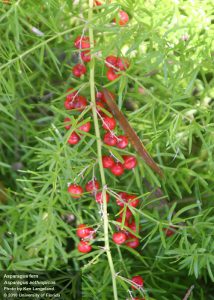Living in Florida offers a unique opportunity to immerse ourselves in the diverse and rich natural landscape. As we appreciate the beauty of our surroundings, it’s essential to be aware of the impact certain plant species can have on our environment. We will explore two fascinating plants that call Florida home – the native Coontie (Zamia floridana) and the invasive Asparagus Fern (Asparagus aethiopicus). Let’s learn more about these plants and how we can nurture the native beauty of Florida while being mindful of the invasives.
Coontie (Zamia floridana) – A Native Beauty
Coontie is our only native cycad species and has been around for millions of years. They were historically abundant in Florida, but their populations declined significantly due to overharvesting and habitat loss. Due to their significance to our ecosystems, efforts have been made to conserve and reintroduce Coontie to its natural habitat. Coontie plants are now often found in parks, botanical gardens, and natural preserves across Florida. Here they are appreciated for their unique appearance and ecological significance.
These plants have a fascinating history as they were once an important food source for Native American tribes in Florida. They used the Coontie’s starchy roots to make flour, which they would process to remove toxins before using it in cooking. Caution do NOT try: The stem is toxic unless prepared properly!
The Coontie thrives within our diverse habitats and can be found in both upland and coastal landscapes. The Coonite plays a significant role in supporting local wildlife and preserving biodiversity. They also play a crucial role in supporting various wildlife, including certain butterfly species that use Coontie as a host plant for their caterpillars. Mammal, insect, amphibians, and reptiles all benefit from this plant’s low-ground covering. The Coontie produces a large amount of seeds, which are consumed by both small mammals and birds.
If you’re interested in observing Coontie in Florida, you might want to visit local botanical gardens, state parks, or some of our County conservation lands where they are protected and maintained. As always, be mindful of the environment and follow any rules and guidelines in place to preserve these beautiful plants and their natural habitats. You can also help conserve this species by incorporating into your landscape. For more information on growing this native species visit the UF/IFAS Florida Friendly Landscaping Planting Guide.
Photo Credit: Kalan Taylor
Asparagus Fern (Asparagus aethiopicus) – A Deceptive Beauty – Loose This!
The Asparagus Fern (Asparagus aethiopicus), also known as the Sprenger’s Asparagus or Lace Fern. Despite its common name, it is not a true fern, but rather a member of the Asparagaceae family. It is native to South Africa. Due to it’s delicate, feathery foliage and bright red berries it is unfortunately a popular ornamental.
Considered as an invasive species in Florida, it has become naturalized in various parts of the state. Growing in the wild, especially in disturbed areas and along roadsides.
As an invasive plant, the Asparagus Fern has the potential to outcompete native vegetation, alter natural habitats, and negatively impact local ecosystems. Its ability to spread rapidly through vegetative growth and the dispersal of its seeds contributes to its invasiveness.
The Florida Exotic Pest Plant Council (FLEPPC) lists Asparagus aethiopicus as a Category I invasive species, which means it has the potential to cause significant ecological harm in the state.
If you come across Asparagus Fern or are considering planting it, it is crucial to avoid its introduction and spread. Instead, choose native plant alternatives, such as the native Coontie. This choice will support the local ecosystem and will not pose a threat to the environment. For more information on removing this invasive species visit the UF/IFAS Center for Aquatic and Invasive Plants website.

Photo Credit: UF/IFAS Center for Aquatic and Invasive Plants, Ken Langeland
Living in the beautiful state of Florida provides us with a chance to embrace the natural wonders that surround us. By choosing to include native plants like Coontie in our landscapes, we support local ecosystems and protect Florida’s heritage. Simultaneously, we must remain vigilant about invasive species such as Asparagus Fern and act responsibly to prevent their spread. Together, we can nurture and preserve Florida’s unique biodiversity, ensuring a sustainable future for generations to come. Let’s celebrate Florida’s native beauty and be responsible stewards of our environment.
Source: UF/IFAS Pest Alert
Note: All images and contents are the property of UF/IFAS.




